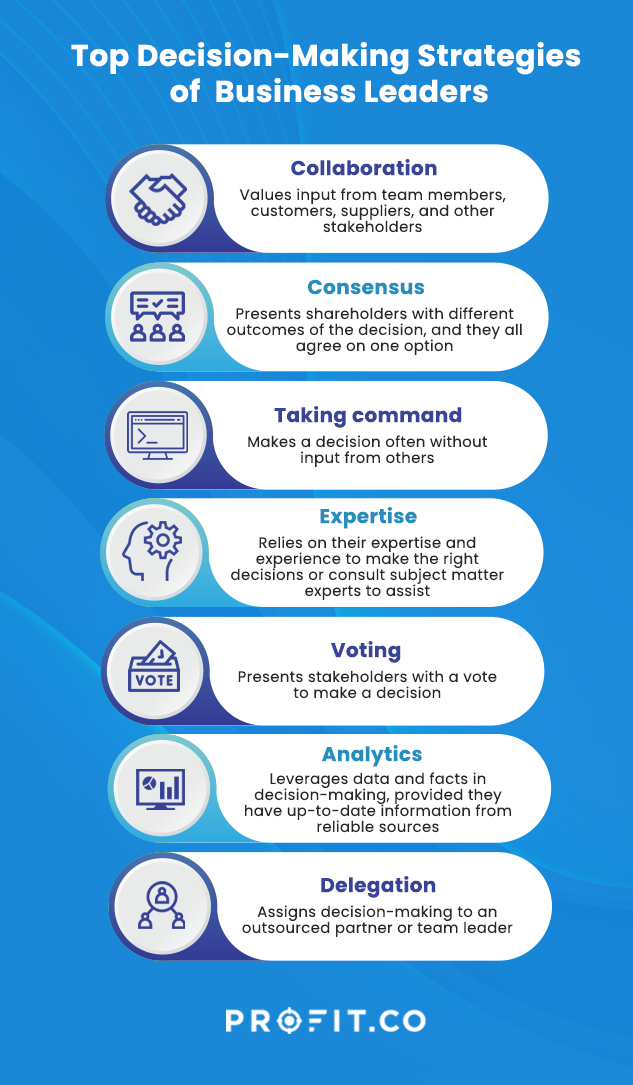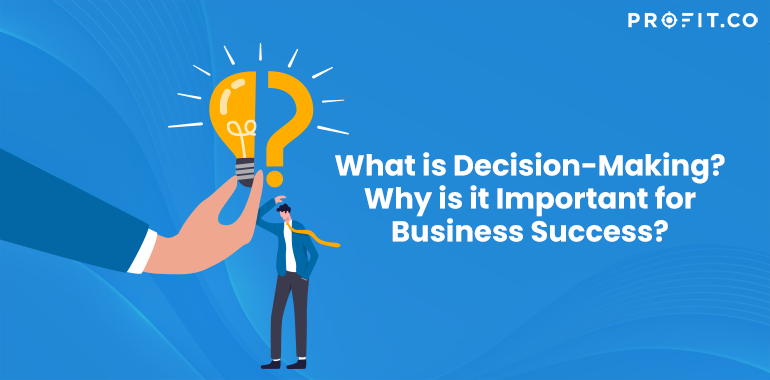In simple terms, decision-making is the ability to make a choice. However, it can become complicated in an organizational context. Business leaders must make critical decisions constantly to ensure smooth operations, customer and employee satisfaction, and profitability.
This guide explores the importance of decision-making and the essential strategies and models to help you make the right business choices.
What is Decision-Making in Business?
Business decisions involve making choices that determine short-term and long-term organizational activities.
A business decision can be
- Operational, e,g., customer orders, department budgets, product inventories, and other day-to-day activities.
- Financial, e.g., product pricing, investment opportunities, production or manufacturing costs, and debt management.
- Strategic, e.g., growing your customer base, mergers and acquisitions, and increasing productivity.
- Recruitment, e.g., job descriptions, vetting potential candidates, onboarding, and training.
- Policy, e.g., employee days off, maternity and paternity leave, compensation, and benefits.
- Technology, e.g., business management software, communication and collaboration systems, and data warehousing.
Why is Decision-Making Important?
The importance of decision-making cannot be understated. Every business choice can positively or negatively impact an organization, so it’s critical to maintain a level head and not be overwhelmed by decision fatigue when making decisions.
When faced with various options that affect your business, good decision-making skills can help you to:
- Adapt and change your organization to ensure its longevity.
- Choose the right initiatives that increase profitability.
- Choose the right business partners that improve efficiency and profits.
- Demonstrate a high level of professionalism in dealing with stakeholders.
- Optimize strategies and operations to meet business goals.
Let’s look at decision-making tools, strategies, and models enabling decision-making and helping you make the best choices for your business.
Ready to start your collaborative journey today?
Five Essential Decision-Making Tools
Decision-making tools can help business leaders to think, analyze data, and prioritize their goals. They also eliminate biases and fallacies, leading to concrete business decisions with positive results.
Evaluate the decision-making tools below and apply them to your context:
1. SWOT analysis
Analyze your strengths, weaknesses, opportunities, and threats surrounding each decision, and choose an outcome that meets your company’s goals and objectives.
2. Cost-benefit analysis
Financial decisions benefit from a cost-benefit analysis to understand whether your choices will positively or negatively impact your bottom line.
3. Pros and Cons
A two-column pros/cons chart can help you outline the benefits and disadvantages of each available decision. Get input from multiple sources to look at your options from every angle and choose the outcome with the most significant advantages for your business.
4. Decision or selection matrix
Use a decision matrix to score each option and tally the results for decisions with multiple outcomes. Determine your decision’s criteria, e.g., price, features, or usability, and assign a number or weight to each. Then, compare each option against these criteria and choose the outcome with the highest score.
5. Pareto analysis (80-20 rule)
The Pareto chart can determine a company’s pain points, allocate resources appropriately, and know which decision has the best outcome. Considering that 20% of actions lead to 80% of results, you can make good decisions about productivity, project management, employee training, and more.
whenever you see a successful business someone once made a courageous decision
What are the Different Decision-Making Strategies?
Decision-making strategies are approaches to making choices when facing various requirements and needs.

Here are some examples of strategies to apply to different business scenarios
1. Collaboration
A collaborative decision-making process values input from team members, customers, suppliers, and other stakeholders. It offers a broad perspective and ensures your decision is objective and balanced to reflect their best interests. Use collaboration during brainstorming and pitching ideas, testing marketing campaigns, or rebranding your business.
2. Consensus
A consensus decision-making approach is when a business leader presents shareholders with different outcomes of the decision, and they all agree on one option. This approach works best when teams are on the same page and aligned with the organization’s mission. However, it becomes challenging to get a consensus if groups are more fragmented or have knowledge silos in each department.
3. Taking command
When a business faces critical, time-sensitive challenges, leaders are pressured to make the right decisions, often without input from others. This command strategy can help a company navigate market disruptions and demonstrate its capability as an industry leader. For example, the Covid-19 pandemic required business leaders to take the right approach toward lockdowns, remote work, and employee healthcare.
4. Expertise
In other cases, business leaders must rely on their expertise and experience to make the right decisions or consult subject matter experts to assist. Thorough knowledge of your field makes decisions seem intuitive, but these decisions come from years of experience and forecasting skills. For example, the rapid and disruptive emergence of artificial intelligence (AI) requires IT, human behavior, and industry trends experts to determine whether its adaptation makes long and short-term business sense.
5. Voting
Some decisions require the majority, so leaders present stakeholders with a vote. This approach is often direct. It saves time because each person’s vote counts, and the most votes determine the final decision. You can also set rules regarding deadlocks and resolve tied votes fairly. For example, stakeholders with more shares can impact the final decision.
6. Analytics
Businesses can also leverage data and facts in decision-making, provided they have up-to-date information from reliable sources. Analytical decision-making applies to data-driven scenarios, such as marketing campaigns with trackable performance metrics (KPIs). For example, you can use data from previous campaigns to inform future initiatives or study competitors’ data to find opportunities to increase your advantage.
7. Delegation
Delegated decision-making to an outsourced partner or team leader in the company’s best interests. This strategy can save time and money, but leaders must know how to choose the right people to delegate. Selecting a digital transformation consultant requires more consideration than the company budget. Team leaders must also be aligned with company objectives and gain peer respect.
What are The Different Decision-Making Models?
To reduce the complexity of decision-making, consider using a decision-making framework or tool to analyze your available choices.
Here are five decision-making models to apply in your business:
1. Rational decision-making model
The rational model is a step-by-step framework that uses data to make choices. It involves identifying the problem, gathering the necessary information, determining your alternatives, and making the best decision based on your analysis. This model yields objective, consistent, and efficient conclusions that stakeholders can trust.
2. Intuitive decision-making model
In contrast, the intuitive model relies on gut instinct to make decisions, usually when facing high-risk options, too many variables, or complex data. It also applies to scenarios with insufficient data where you must fill in the gaps with your experiences, values, or beliefs. While the intuitive model can enable quicker decision-making, it’s also prone to biases like availability heuristic and representative heuristic or oversimplifying problems. Use the intuitive model only in rapidly-changing situations where extensively analyzing data may put the business at risk.
3. Recognition-Primed Decision (RPD) model
The recognition-primed decision model emphasizes one’s experience in decision-making. An expert can spot patterns in past situations and apply that knowledge to current decisions, making faster, more accurate choices without relying on data. RPD encourages creativity and collaboration among professionals with similar backgrounds and experiences.
4. Vroom-Yetton decision-making model
Developed in 1973, the Vroom-Yetton model considers managers’ leadership styles when faced with difficult business decisions. It places the importance of decision-making in your leadership approach, whereby an autocratic leader makes all decisions. In contrast, a democratic leader involves all shareholders.
An autocratic approach saves time and keeps the business afloat if the decision requires a fast response, such as during economic upheavals. However, if the decision significantly impacts employees and customers, such as a shift to remote or hybrid work, a democratic approach can gather opinions and suggestions about the best way forward.
5. Bounded rationality decision-making model
When making strategic or policy decisions, the bounded rationality model of decision-making enables leaders to recognize their constraints, e.g., time, experience, resources, biases, and emotions. Since we don’t always have all the facts or time to consider all options, we rely on intuition and mental shortcuts to fill the gaps.
While other decision-making models assume that leaders have perfect information or limitless resources to make the right choices, this model enables leaders to acknowledge that they’re flawed humans and that their decisions won’t always be perfect.
How to Make Faster, Better Decisions?
Business leaders understand that having more data can negatively impact decision-making. Too much data can be overwhelming and slow down the decision-making process, decreasing productivity. One way to make more effective, straightforward business decisions is to understand the risk and frequency of each decision, as explained below:
- Some decisions happen rarely but carry high risk, e.g., mergers and acquisitions. These decisions need enough time, information, and debate because they shape your company’s future.
- Other decisions often carry significant risks, e.g., changing your pricing to reflect market conditions. These decisions need accurate departmental data to determine objectives, targets, and expected outcomes.
- In addition, some decisions happen frequently but carry low risk, e.g., planning a department’s schedule. Leaders can delegate these decisions to team leaders to increase engagement and meet business objectives.
Once you understand where your business decisions fall in these categories, you can apply the ideal strategy and model for the best outcomes.
FAQs
1. What are the main types of business decisions?
Business decisions can be operational, strategic, financial, technological, or policy-related, all affecting the success and efficiency of a company.
2. What tools can managers use in decision-making?
Decision-making tools include SWOT analysis, the Pareto principle, cost-benefit analysis, and decision matrix.
3. Which strategies can managers use in decision-making?
Decision-making strategies include collaboration, consensus, voting, delegation, expertise, analytics, and taking command.
Conclusion
Decision-making is a significant part of leadership and management, and it must be efficient and accurate to optimize a business. Unfortunately, business leaders are humans under pressure, working with either limited information or excess data to make critical decisions. With the strategies and tools described in this guide, you can improve your chances of making high-risk or low-impact decisions for your business to perform in a dynamic marketplace.

